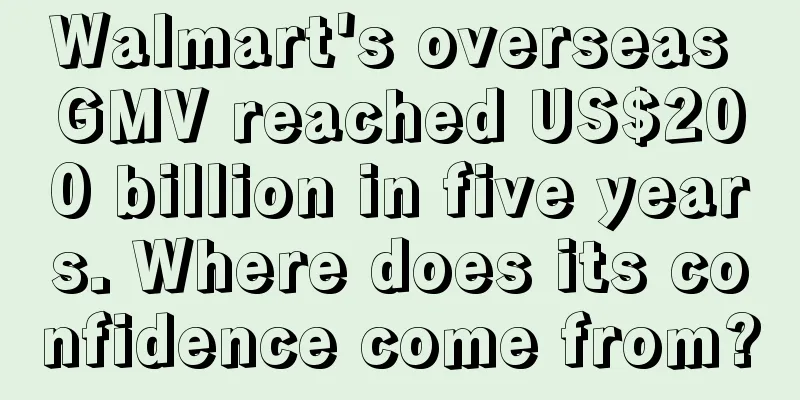Walmart's overseas GMV reached US$200 billion in five years. Where does its confidence come from?

|
It is learned that on June 2, Walmart International CEO Judith McKenna said at the annual shareholders' meeting that despite the continued instability of the global economy, Walmart still expects to double its total merchandise sales in foreign markets to US$200 billion within five years.
McKenna first announced Walmart's goal of doubling its overseas gross merchandise volume in April and has stuck with it even after the International Monetary Fund cut its global economic growth forecasts for 2023 and 2024, citing ongoing inflation concerns as a benefit.
Gross merchandise volume (GMV) measures the total value of all goods sold through a platform or marketplace, Walmart's businesses outside the United States, including the Cashi digital payment app platform in Mexico and the Flipkart marketplace in India.
According to Reuters, Walmart's international business had a total GMV of $120 billion five years ago, but after divesting its businesses in the UK, Brazil, Argentina and Japan, that figure fell to $100 billion in the fiscal year ending January 31, 2023.
Walmart's business model has changed over the past few years, with a greater focus on omnichannel.
McKenna said Walmart's growth will mainly come from implementing its omnichannel strategy globally, further expanding its market share in its existing 19 foreign markets and building an "ecosystem" of complementary businesses similar to the one in Mexico.
In addition to selling everyday items through its physical stores in Mexico, Walmart also offers financial services through its Cashi app, telecommunications services through BAIT, and now healthcare services in the country. Walmart’s omnichannel expansion efforts have led to a significant increase in its profits.
In the Indian e-commerce market, Flipkart, which is held by Walmart, far exceeds Amazon in market share. Flipkart has a 48% market share, almost twice that of Amazon's 26%. Flipkart's total sales in India in 2021 were $23 billion, while Amazon's were $18 billion to $20 billion.
Walmart has also surpassed Amazon in terms of share of the overall U.S. grocery market. Walmart’s share of the overall food and beverage market is about seven times larger than Amazon’s, according to PYMNTS.
As more of household budgets go to food, Walmart and other retailers are rethinking how they price apparel, home furnishings and other discretionary products or offering more discounts. For the upcoming back-to-school season, Walmart plans to offer lower prices on items such as notebooks or pens or pencils, and will offer more quantity and alternatives. Editor✎ Ashley/ Disclaimer: This article is copyrighted and may not be reproduced without permission. |
<<: Luxury spending in the U.S. slows, to rise slightly by 6.7% in 2023
>>: Shein and Temu are popular in the United States, but eBay still holds the position
Recommend
Etsy's buyer group portrait is released! Female buyers account for 75% of the total!
<span data-shimo-docs="[[20,"获悉,据Etsy的研究发现...
U.S. ports handled 2.34 million TEUs in April! Shanghai ports will be busy again after the lockdown is lifted!
<span data-shimo-docs="[[20,"获悉,根据美国零售联合会(...
Shopify increases subscription fees for new users in the U.S.! Prices will also rise in Europe!
Leading e-commerce platform Shopify has increased...
What is Olive? Olive Review
Olive is a healthcare company focused on artificia...
Tariffs are higher than costs?! A big net is set up to trap Amazon sellers
As the dark horse site of Amazon last year, selle...
Walmart opens second high-tech distribution center to speed up order delivery
Walmart will open a 2.2 million square foot distri...
The US government has repeatedly issued TikTok "bans", and the president of Toutiao has transferred to TikTok e-commerce
Under the attack of Amazon's account suspensio...
Walmart recalls baby products for violating federal safety regulations
It is learned that the U.S. Consumer Product Safet...
Memorial Day is a shopping day! More than 90% of American celebrants plan to shop!
According to the "Second Quarter Holiday Prev...
Newegg's revenue in the first half of 2024 was US$618 million, a year-on-year decrease of 14.5%.
It is learned that the US e-commerce platform Newe...
Tens of thousands of sellers' stores have been blocked! ? Amazon is cracking down again
In the past two days, foreign media broke a big ne...
What is Czech VAT registration? Czech VAT registration review
VAT is the abbreviation of Value Added Tax, which ...
What is Elabelz? Elabelz Review
Elabelz, a local e-commerce company in the Middle ...
What is Lowe's? Lowe's Review
Lowe 's originated from a small town hardware ...
Halloween spending in the U.S. will hit a new high in 2022! These categories have the best chance of making big sales
<span data-docs-delta="[[20,"获悉,根据美国零售联合会(...









